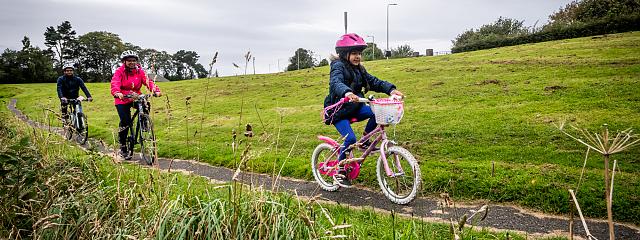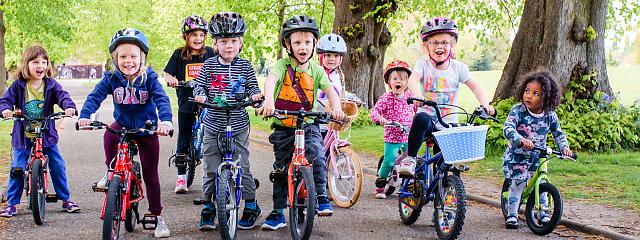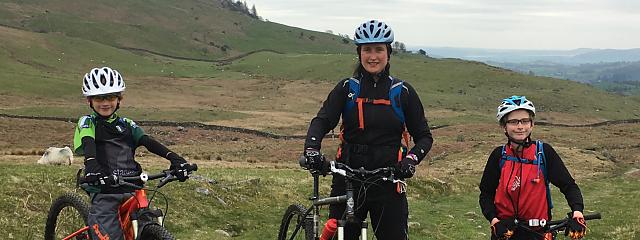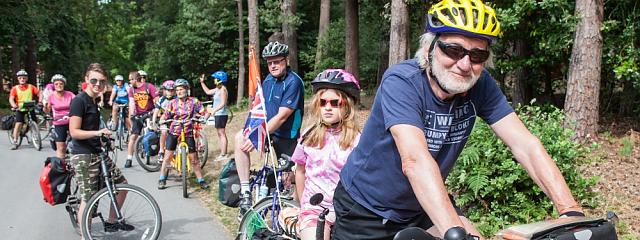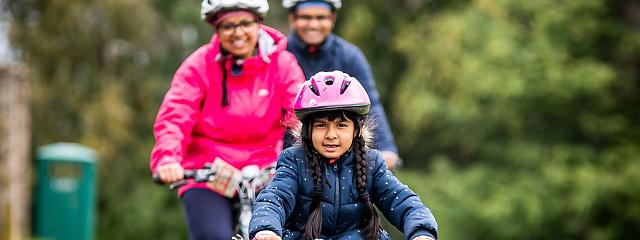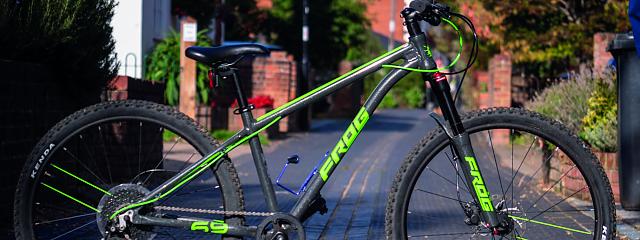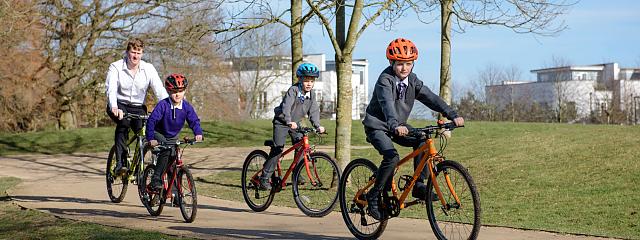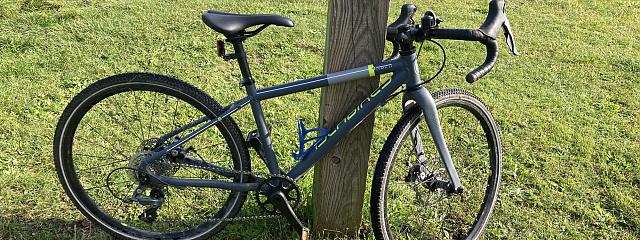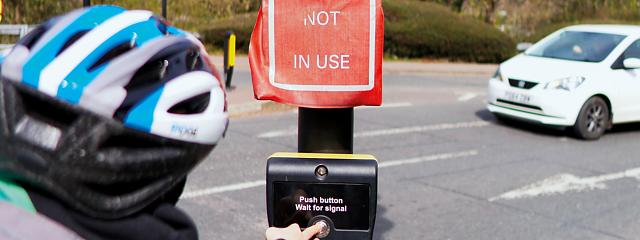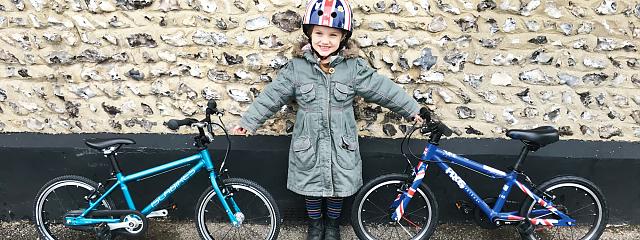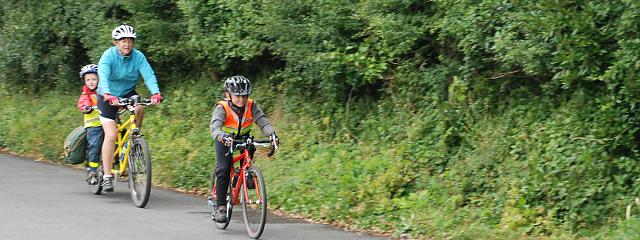
How to cycle on the road with children
How to cycle on the road with children
Some parents will baulk at the idea of letting their children near roads with traffic, let alone on them. It would be foolish to pretend there are no risks involved.
However, at some point your child will use roads alone – if not on a bike, then as a pedestrian or behind the wheel of a car as a young adult. Those who are used to independence and who can make risk assessments will be safer, better road users than those who have been isolated from the outside world.
It doesn’t require leaping in at the deep end. Exposure to traffic is something best done by degrees starting on quiet road.
Co-riders and passengers
To begin with, your child will travel on the road under your direct control, either as a passenger in a child seat or trailer or as a co-rider on a tandem or tag-a-long. As steering and braking are under your sole control, the only impact will be on how you cycle with an extra load.
You will inevitably ride in a less swashbuckling style. Mostly it’s because you are always more careful when kids are around; it’s human nature. Partly it’s because a heavier bicycle takes longer to get up to speed and to slow down, so your riding benefits from being smoother and less stop-start.
Try to anticipate junctions by arriving slowly and in the right gear for setting off. Allow for the extra second or two you’ll need to pull away when judging gaps in traffic.
If you scrupulously observe the rules for solo cycling, you can cycle safely with children on quite busy roads. Nevertheless, quieter routes are better. They’re simply more pleasant.
You can chat easily if you’re not drowned out by traffic noise, and an enjoyable trip will give your child positive associations with cycling rather than negative ones. So what if the quiet route is a bit further or takes five minutes longer?
A child on a tandem or tag-a-long or in a cargo bike may pick up some traffic skills from you. You can reinforce this by asking an older child to look to see if there’s anything behind and to signal left or right when needed. (You will still have to do both these things yourself, though.)
Tandems remain useful up to the age of 11 and possibly beyond. By that age, though, most children will want to ride solo. One reason is image. The desire to conform becomes very strong and children don’t want to be seen as ‘different’ by their friends. The tandem that was once so popular may now be seen as geeky.
Even when you’re chaperoning on a solo bike, it’s worth looking at things through your child’s eyes and maybe making one or two concessions. Riding with your pre-teen son on an urban mountain bike will likely be acceptable, even cool. Riding a small-wheeled folding bike while wearing luminous trouser bands may be highly embarrassing. Only you can decide where to draw the line here.
Chaperoned cycling
Traffic awareness develops around the age of 8-10 years old, which is usually when school-based cycle training called Bikeability tends to start. Up until that time, at least, you will need to supervise your child on roads. He or she might be a proficient cyclist and yet make misjudgements about traffic simply because they are too young to consider different elements of road safety at the same time.
Before you set off
Before setting out together there are some things you need to be sure of. One is that your child can stop, start, steer and otherwise be competent at cycling – on a bike that’s roadworthy.
Another is that your child will respond to your instructions, doing what you say, when you say it. Do explain the reasons for this in advance: you’re not being bossy or cross, just careful.
The final requirement is that your child knows the difference between left and right. When you say ‘go left’ it’s important your charge doesn’t cycle into the centre of the road instead.
On the road
When you’re riding, it’s best if your child leads and you cycle a bike length or half a bike length behind. That way you can watch your child at all times and call out instructions.
Your child should ride towards the left side of the road, but at least 50cm out from gutter, while you ride further out, possibly taking the lane. This means traffic has to come around you and can’t cut in too close to your child, who might veer or wobble or simply be intimidated by cars passing too close.
If you need to, it is perfectly legal to cycle side-by-side with your child. Many drivers are unaware that cyclists can ride two abreast, so be prepared for the odd pipped horn – although the updated Highway Code has made this clearer.
It’s worth moving forward to ride alongside as you come up to a side road. Two cyclists are more visible than one, and with both of you to pass, any side-road driver is less likely to engage in the brinkmanship of edging or accelerating out in front of you.
On quiet roads, conversely, you may wish to relinquish the lane and ride directly behind your child. This gives your child the opportunity to look behind to check for traffic, without having you in the way. It’s not essential, since you’re covering the job of traffic observer anyway, but it is good practice.
Give encouragement as you ride along and make your instructions calm and clear. Information should flow both ways. In particular, your child should be taught to say ‘Stopping!’ rather than halting right in front of you without warning.
Ideally, your child should also signal left before pulling in to the side. No one uses the one-armed up-down flap that signifies slowing down nowadays, and it may only confuse drivers.
If there are two adults, the child or children should ride in the middle with an adult front and back. If there are two children to one adult, it’s best if the more competent child cyclist leads, followed by the second child, then the adult.
A skilled older child cyclist can ride behind you, leaving you free to concentrate on just one rider in front.
Start on easier, less trafficked roads and work up. There will be situations in which it is easier or necessary to get off the bikes. Perhaps a hill is too steep. Perhaps a junction is too complex. In time your child will be able to ride these. For now, take it one step at a time.
And remember: communication, communication, communication.
After the ride
After the ride, accentuate the positive. Too much ‘don’t do this’, ‘don’t do that’ can be a real downer when you’re eight years old.
Independent cycling
Independent cycling means riding on the road. Children cycling on the pavement is illegal, but there is no criminal liability for children under the age of 10, and it is tacitly accepted by everyone that the pavement is where younger children will ride.
By the age of 11, however, and perhaps two or three years earlier, (if you feel they are capable of it) most children can learn to ride safely on the road without supervision – not on all roads but certainly on roads that aren’t busy and don’t have complex junctions.
Cycle training has traditionally taken place in the later years of primary school but sadly not all schools have sessions. At that age, not only are children ready for training then, they will soon need it.
The average distance from home to secondary school is 3.3 miles in England – too far to walk perhaps, but not difficult by bike. Add in a wider catchment area for friends and, depending on public transport options, children will need to cycle if they’re to get about independently.
Training has moved on quite a way since the cones-in-the-school-playground days of the Cycling Proficiency Scheme. The National Standard for Cycle Training (called Bikeability) takes place largely on the road in real-world, supervised conditions. And the training itself is no longer administered by schoolteachers but by qualified, accredited cycle instructors.
There are three levels to Bikeability training:
- Level 1 is for beginners and covers basic cycle control skills, such as starting, stopping, manoeuvring, signalling, and using the gears. It takes place away from roads and traffic.
- Level 2 is an introduction to on-road cycling, and that’s where the training largely takes place. It covers skills such as positioning on the road, turning left and right, and overtaking. By the end of it, participants should have the ability and confidence to tackle short commuting journeys.
- Level 3 teaches existing cyclists how to travel on any road. It covers more advanced skills such as roundabouts, filtering, complex turns and junctions. The emphasis is not so much on physically riding the bike – which participants will know – but how to make journeys by bike confidently and effectively.
Local authorities sometimes provide free or subsidised training. Your nearest cycle training provider can fill you in about charging policy. Always ask your school if they will consider Bikeability sessions as funding is often available to them but many schools do not know how to access it.
Teaching your child cycle skills yourself
Strictly speaking, it isn’t essential to have any training to ride a bicycle on the road, inasmuch as it’s not a legal requirement. It is, however, a practical requirement and it should not be overlooked. If you’re unable to arrange training with an accredited National Standard cycle instructor, it’s something you need to take charge of.
Your child may pick up some skills from you through copying you as you cycle together. Don’t depend on this, though. You will need to check.
The best way to assess cycling ability is to shadow your child on a journey. This is like chaperoning except that you’re not giving instructions and you’re riding directly behind. You’re just there to observe, and to step in if necessary.
You’re looking for a number of key skills. Bike control is probably a given by this point, but before setting out on the road do monitor things like the ability to ride one handed and to ride without veering to one side while looking behind.
On top of that, check:
- Traffic awareness. Your child must look behind before changing position on the road and before slowing down. Try holding a certain number of fingers in the air for a few seconds to check if he or she is really looking.
- Communication. Using eye contact, positioning and signalling, your child needs to be able to communicate intentions clearly to other road users.
- Junctions. Explain who has priority and what the best way is to go through a given junction. Use real-world examples.
- Positioning. Your child might not want to take the lane. It’s easy to get bullied out of doing so by following traffic. You can nevertheless drill in the requirement to ride a good way out of the gutter.
- Bike awareness. Show your child how to check if a bike is roadworthy. Brakes work? Tyres firm enough? Quick releases done up? Nothing loose? Note that ‘roadworthy’ also means lights and a rear reflector at night. You’re not expecting your child to fix any problems, just to alert you if there are any and not to head out the door on an unsafe bike.
- As teenagers get older, they will want to be more independent. They won’t want to be chaperoned or even shadowed. Nevertheless, it’s worth doing dry runs yourself of any journeys that you know they will make. That way you can still offer practical suggestions about what to watch out for on the journey, or on alternative routes.
Finally, do have fun and take snacks as cycling with your children is a great way to spend time as a family, get exercise, save fuel and discover new places.






